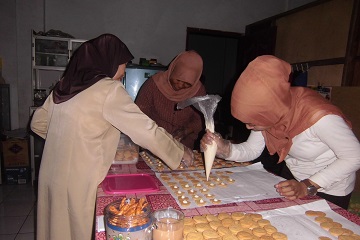IPB Produced Biscuits Made of Blondo, Asian Snakehead Fish and Red Rice for Improving Children’s Nutrition

In childhood age, toddlers’ growth and development occur very quickly so that high intake of nutrients is required. If the child does not get special attention, then the nutritional problems will be very easy to come. Therefore, children should be given appropriate care, especially in the fulfillment of food and nutritional needs. Optimizing the handling of nutritional problems in toddlers can be done through the development of additional food formula by considering nutritional aspects and health benefits as well as utilizing local food resources. Local food ingredients include blondo, Asian snakehead fish (Channa striata) and red rice (Oryza nivara).
The research team consisting of Hadi Riyadi and Ikeu Tanziha from the Department of Community Nutrition, Faculty of Human Ecology (Fema) of Bogor Agricultural University (IPB); Slamet Widodo from the Department of Family Welfare Education, Faculty of Engineering, State University of Makassar; as well as Made Astawan from the Department of Food Science and Technology, Faculty of Agricultural Technology (Fateta) of IPB, conducted a research on improving the nutritional status of toddlers by giving biscuits made of blondo, Asian snakehead fish (Channa striata) and red rice (Oryza nivara).
Hadi explained that blondo, part of coconut that is not used in making coconut oil, contains 9.5 grams of protein per 100 grams of blondo. The nutritional potential of blondo is very good in improving the nutrient content of various foods, especially foods for malnourished children. Another nutrient-rich food is Asian snakehead fish which has high quality of complete animal protein content. It contains complete essential amino acids which composition closes to the amino acids the body needs, and its high digestibility leads to the high amounts of absorption.
In this study, a total of 50 toddlers suffering malnutrition in age range of 3-5 years became the subject and they were divided into two groups, namely treatment and control groups. The treatment group was given biscuits for 90 days. Measurement of body weight, height and albumin serum levels was done before and after intervention.
The results indicated changes in energy intake between beginning and end of treatment period. In the control group, there was 20.8 kcal energy, while the treatment group owned 45.6 kkal. The protein intake in control group was 9.5 grams, while in treatment group was 16.6 grams. The body weight in control group changed from 11.7 kilograms (kg) to 13.3 kg, while in the treatment group from 11.7 kg to 13.6 kg. The control group albumin increased by 0.3 g/dL, while in the treatment group was 1.0 g/dL.
The researcher explained that gain of weight and albumin after consuming biscuits can improve nutritional status of malnourished children. Thus, it can be concluded that biscuits made of blondo, Asian snakehead fish flour and red rice flour for 90 days can improve the nutritional status of body weight towards age, body weight towards height and albumin serum level in malnourished children less than 3-5 years old.
"Biscuits made of blondo, Asian snakehead fish flour and red rice flour can be used as a protein feeding program to overcome the problem of malnourished children or be served as fast food in emergency situations such as during natural disasters and starvation conditions, especially for children under five years old," said Hadi. (TK)



